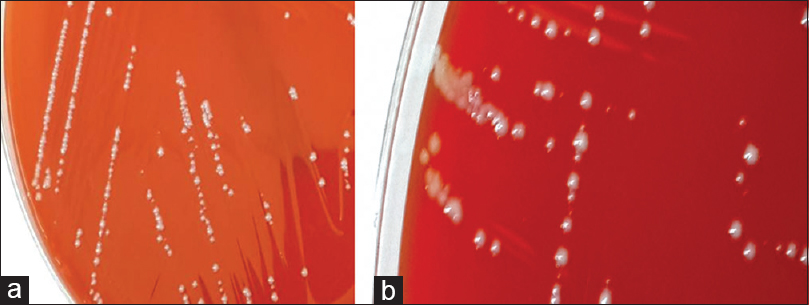Translate this page into:
Staphylococcal Small Colony Variants from a Libyan Hospital
Address for correspondence: Dr. Mohamed O Ahmed, E-mail: a.mo@live.com
This is an open-access article distributed under the terms of the Creative Commons Attribution-Noncommercial-Share Alike 3.0 Unported, which permits unrestricted use, distribution, and reproduction in any medium, provided the original work is properly cited.
This article was originally published by Medknow Publications & Media Pvt Ltd and was migrated to Scientific Scholar after the change of Publisher.
Sir,
Bacterial small colony variants (SCVs) are natural subpopulation developed by many bacterial species in response to several factors, including antibiotic use and environmental stressors.[12] These variants have been increasingly reported in various clinical samples, representing either persistent colonization, fatal infection cases in humans or cases related to antibiotic use in humans and animals.[134] Bacterial SCVs, particularly of staphylococcal species, are widely reported and characterized by small colonial growth and reduced to variable biochemical and virulence traits at genera and species level.[1] These properties can significantly complicate the laboratory and diagnostic testing and may result in therapeutic failures. A bacterial cultures of Gram-positive cocci (n = 5) of clinical sources from a hospital in Tripoli that developed subpopulation colonial growth, and atypical phenotypic characteristics were investigated for SVCs [Figure 1]. These were identified as Staphylococcus aureus (n = 2), Staphylococcus epidermidis (n = 1) and Staphylococcus hominis (n = 2) using the Vitek automated identification system using the typical growing colonies (wild type [WT]).

- Small colony variants growth and characterization on blood agar medium. (a and b) Staphylococci growth (SVCs and wild-type colonies)
The isolates were grown overnight on sheep blood agar (Oxoid) supplemented with 5% NaCl and mannitol salt agar and incubated at 35°C for 48–72 h. Single small colonies from each culture were further tested and characterized as SCVs if they showed typical pinpoint growth (1/10 of typical growing colony) and reduced/variable hemolysis and pigmentation properties, following the recommendations of recent reports.[56] SCVs were continuously sub-cultured on sheep blood agar for 7 consecutive days in order to observe the density of SCVs and the ability to revert into WT colonies. All isolates showed typical SCVs and variable phenotypic properties. SCV cultures showed reduced density after 5 days of sub-culturing.
Staphylococcal SCVs have been widely reported from different clinical sources and largely associated with antibiotic therapies.[17] The slow growth property and other variable phenotypic characteristics are associated with variable susceptibility to antimicrobial agents, which is sometimes transient, compromising the accurately of the laboratory testing.[12] The intracellular growth characteristics and reversion ability of SCVs into its WT are another laboratory complications and appear to occur regardless the selective pressures known to induce SCV formation.[689] The small studied isolates were from a hospital environment, and such stressful environment has likely contributed to the formation of SVCs.[6]
Bacterial SCVs are a laboratory challenge, largely associated with antimicrobial therapies and limit the diagnostic and treatment options.[17] Identification and characterization of SCVs depend largely on phenotypic and morphologic characterization using recommended laboratory procedures.[56] The information in this report should serve to alert hospital management teams and laboratory professionals of the difficulties associated with the identification of such variants and the high risk of misdiagnosis mainly in developing countries.
REFERENCES
- Small colony variants: A pathogenic form of bacteria that facilitates persistent and recurrent infections. Nat Rev Microbiol. 2006;4:295-305.
- [Google Scholar]
- Small colony variants (SCVs) of Staphylococcus aureus – A bacterial survival strategy. Infect Genet Evol. 2014;21:515-22.
- [Google Scholar]
- Antibiotic activity against small-colony variants of Staphylococcus aureus: Review of in vitro, animal and clinical data. J Antimicrob Chemother. 2013;68:1455-64.
- [Google Scholar]
- Fatal case due to methicillin-resistant Staphylococcus aureus small colony variants in an AIDS patient. Emerg Infect Dis. 1999;5:450-3.
- [Google Scholar]
- Prevalence and genetic diversity of Staphylococcus aureus small-colony variants in cystic fibrosis patients. Clin Microbiol Infect. 2013;19:77-84.
- [Google Scholar]
- Phenotypic variants of staphylococci and their underlying population distributions following exposure to stress. PLoS One. 2013;8:e77614.
- [Google Scholar]
- Staphylococcus aureus small colony variants: A challenge to microbiologists and clinicians. Int J Antimicrob Agents. 2008;31:507-10.
- [Google Scholar]
- Staphylococcus aureus small-colony variants are adapted phenotypes for intracellular persistence. J Infect Dis. 2010;202:1031-40.
- [Google Scholar]
- Staphylococcus aureus as an intracellular pathogen: The role of small colony variants. Trends Microbiol. 2009;17:54-8.
- [Google Scholar]




